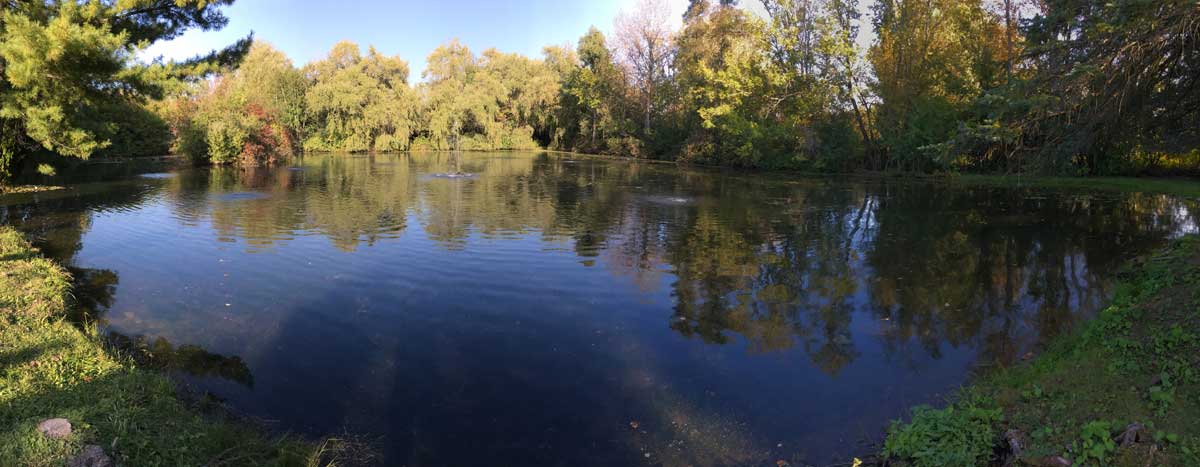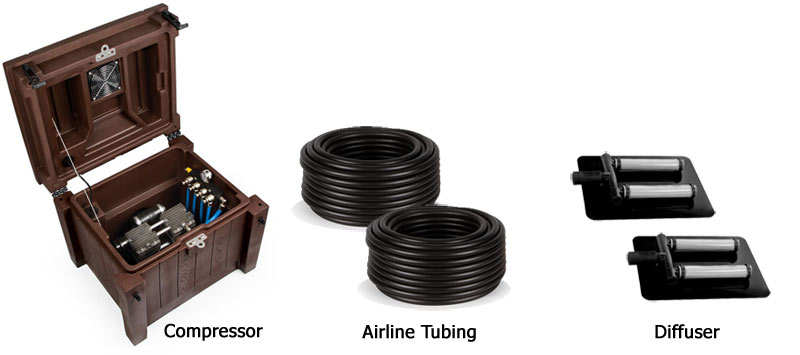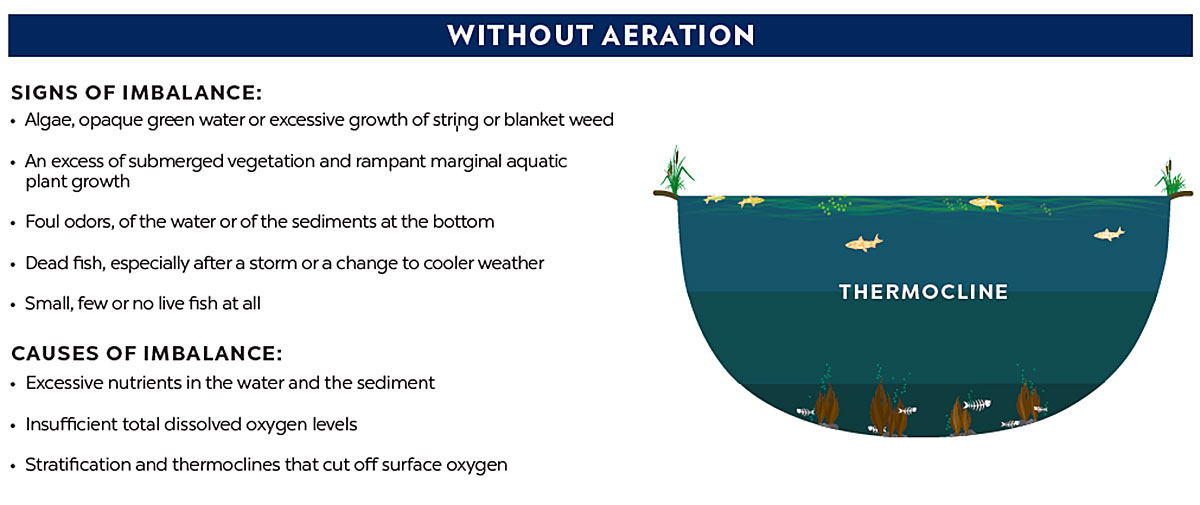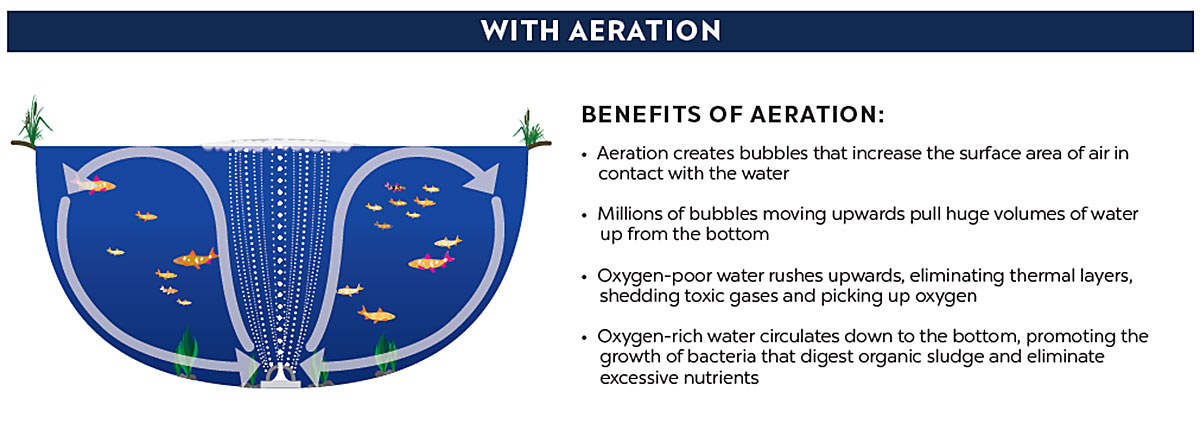Pond aeration, specifically subsurface pond aeration is the most important thing you can add your pond to improve water clarity, water quality and reduce algae and weed growth. The most effective way to aerate a large natural pond is to introduce diffused air directly into the water with a Subsurface Aeration System. Subsurface aeration works from the bottom up, by using a compressor to pump air down to the bottom of the pond, through a diffuser which produces fine bubbles that rise to the surface of the pond.

For more information on how to determine what size aeration system you need for your pond, visit our How to Size an Aeration System for A Large Pond page.
We also have other articles that will help you keep your pond looking is best such as: Large Pond Weed Control, Large Pond Algae Control and Large Pond Muck & Sludge.
There are 3 main components in a subsurface pond aeration system.
1. Compressor – is heart of the system. The compressor is a pump that produces compressed air that is delivered to the bottom of the pond. Compressors are usually placed on the shore, near the pond, however, they can also be placed several hundred feet away from the pond.
2. Tubing – the airline tubing carries the air produced by the compressor down to the bottom of the pond. The 2 most common types of tubing are Vinyl and PVC. Vinyl tubing is thin walled will float when the compressor is operating. Weights must be attached to it vinyl tubing to keep it submerged. PVC tubing has a much thicker wall and is naturally self-weighted. It will remain on the bottom by itself at all times and it is also more durable and longer lasting.
3. Diffuser – the diffuser is attached to the airline at the bottom of the pond. It is used to break up the air into fine bubbles creating more effective circulation and aeration. There are several types of air diffusers.

We carry many different types and sizes of pond aeration systems for ponds of all sizes. Visit our Lake & Large Pond Aerators page to find an aeration system that is right for your pond.
Aeration aids in the breakdown of decaying organic matter and vegetation such as submerged plants, tree leaves, grass clippings, algae and other things like fish waste. This breakdown of organic matter on the bottom is carried out by beneficial bacteria and enzymes in the top layers of muck, aeration helps these bacteria do a better job digesting this waste. There are several other ways in which aeration can help your pond such as improving water quality and clarity, reduce algae blooms, reduce fish kills and reduce odours.
The break-down or decomposition of organic matter on the bottom of the pond can be carried out in 2 ways:
Anaerobic decomposition occurs when the oxygen level at the bottom of the pond is low. The strains bacteria that can survive in low oxygen levels are able to slowly break down the muck and sludge, however, they don’t really do a good job. With these anaerobic bacteria, decomposition is slower and less complete, and the end products are sludge and toxic gases such as ammonia, methane and hydrogen sulfide (rotten egg smell!). With anaerobic decomposition, organic matter, sludge and muck increases each year because they accumulate faster than they can be broken down.

Low oxygen levels typically occur in ponds with no aeration during the summer. As the sun warms up the pond in the spring, a layer of warm water begins to develop on the surface. This layer of warm water grows throughout the summer and it ‘sits’ on top of the cooler water below at a boundary called a Thermocline. These layers of warm and cool water don’t mix during the summer, a process called stratification. You may have noticed this phenomenon if you have ever jumped into a lake or pond and noticed that the deeper water is much cooler, down near your feet. The bottom layer of water becomes lower and lower in oxygen because it does not get a chance to don’t mix with the surface of the pond – the only place it can pick up oxygen. As the oxygen level decreases, slow, incomplete anaerobic decomposition takes place, and sludge and muck begin to accumulate.
Aerobic decomposition (the good kind of decomposition) occurs when there is a continuous supply of oxygen at the bottom of the pond. Beneficial aerobic bacteria and enzymes use oxygen to quickly and thoroughly digest organic matter and sludge on the bottom of the pond. In ponds with aeration, aerobic decomposition can take place all summer, greatly reducing sludge accumulation.

So what does this all mean? Pond aeration helps to greatly increase the rapid decomposition and digestion of sludge. This is important because sludge and muck release nutrients in the pond. These excess nutrients promote algae blooms, cloudy water and weed growth. Aeration greatly helps to reduce muck and sludge, which reduces the amount of nutrients in the pond. With less nutrients available, there will be less algae, improved water clarity and reduced aquatic weed growth.
In older ponds, that already have a substantial layer of sludge and muck, the addition of aeration combined with the addition of natural sludge eating bacteria like MuckAway can reverse the ‘aging’ process and significantly remove several inches of sludge each year. The result will be cleaner clearer water with less aquatic weed growth and less algae growth.
In newer ponds, that have little or no sludge, adding aeration will keep the pond in pristine condition, helping to prevent future algae blooms and reduce aquatic weed growth.
If you are thinking of adding an aeration system to your pond and would like to have one installed visit our Pond Maintenance & Installation Services page for more information.